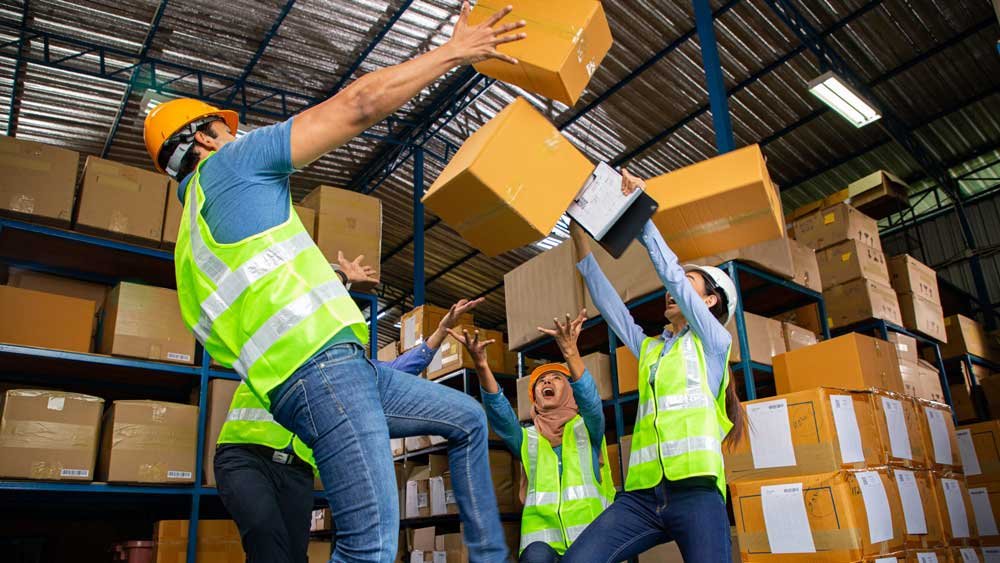Why do we need to go ahead and praise people who follow safety guidelines in their daily warehouse operations? Because workplace safety is very important, we need to praise people who maintain and focus on workplace safety and push for this practice.
Warehouses are filled with many potential hazards, so workplace safety in warehouses is very important, and this is a topic that many of us are discussing right now.
So next, let’s talk about what we should all be doing on the topic of workplace safety!

The Importance of Workplace Safety
Before we start talking about what we can do to promote workplace safety, it’s good to understand what benefits we can gain as a business if we make our workplace safer.
Protecting the lives and health of employees
Warehouses often have a variety of potential hazards, such as the operation of heavy equipment (e.g., forklifts), falling from heights, dropping items, or slipping and falling. Implementing safety measures can reduce accidents and protect the lives and health of employees.
Improve work efficiency
A safe work environment allows employees to work with greater peace of mind, reduces distractions caused by concerns about safety, and improves overall work efficiency.
Reduce Business Costs
Accidents can result in medical expenses, workers’ compensation, legal liabilities, and equipment repair costs. Preventive safety measures can effectively reduce these costs.
Compliance with laws and regulations
Countries often have legal requirements regarding workplace safety, such as OSHA (Occupational Safety and Health Administration) regulations in the United States. If a business fails to comply with regulations, it can face hefty fines or shutdown penalties.
Protecting your business reputation
Safety incidents don’t just affect employees; they can also affect the supply chain, customers, and the public’s trust in a business. A business that focuses on safety is more likely to gain the trust of its partners and customers.
Reduce work disruption and loss
Safety incidents can lead to workplace downtime, affecting production and order fulfillment. And good security management ensures continuity of business processes.
Ways to Promote Workplace Safety
Once we understand what can be gained by making workplace safety better, then it’s time to start thinking about what should be done to promote workplace safety? And my answer is in what follows:
Develop and Implement a Safety Policy
- Safety Regulations
- Establish comprehensive safety protocols, covering operating procedures, hazardous material handling, and equipment usage.
- Risk Assessment
- Conduct regular risk assessments to identify potential hazards and implement targeted mitigation measures.
- Monitoring Mechanisms
- Appoint a dedicated safety team or officer to oversee the enforcement of safety policies.
Provide Employee Training
- Safety Awareness Training
- Educate employees on safety principles and help them recognize warning signs of potential hazards.
- Equipment Operation Training
- Offer professional training and certification for operators of forklifts, cranes, and other heavy machinery.
- Emergency Response Training
- Train employees to handle emergencies, including fires, chemical spills, and injuries.
Improve Equipment and Facilities
- Safety Equipment
- Install protective barriers, anti-slip flooring, and rack guards.
- Equip the workplace with first aid kits, fire extinguishers, and personal protective equipment (e.g., helmets, safety shoes, gloves).
- Maintenance and Inspection
- Schedule regular maintenance for forklifts, racks, and conveyor belts.
- Ensure fire extinguishers and smoke detectors are in optimal condition.
- Enhanced Lighting
- Provide adequate and even lighting, particularly in work and high-risk areas.
Optimize Warehouse Layout
- Clear Path Markings
- Use color coding or signs to designate pedestrian walkways and equipment routes.
- Proper Rack Arrangement
- Avoid overloading or stacking goods too high; ensure racks are stable and secure.
- Designated Hazard Zones
- Clearly mark high-risk areas (e.g., heavy equipment operation zones) and restrict unauthorized access.
Implement Behavior-Based Safety Management
- Behavior Observation
- Monitor daily work activities to identify and correct unsafe behaviors promptly.
- Reward System
- Encourage employees to report safety hazards and reward teams or individuals who excel in safety practices.
Establish an Emergency Response System
- Emergency Plans
- Develop detailed contingency plans for fire, chemical spills, earthquakes, and other emergencies.
- Drills
- Organize regular emergency drills to familiarize employees with evacuation routes and procedures.
- Alarm Systems
- Install fire alarms, chemical spill detectors, and other alert systems for timely responses.
Incorporate Technology
- Monitoring Systems
- Use cameras to oversee warehouse activities and detect unsafe behaviors or zones.
- Automation
- Introduce automated equipment, such as forklifts and AGVs (Automated Guided Vehicles), to reduce manual operation risks.
- Environmental Monitoring
- Install sensors to monitor air quality, temperature, and humidity, preventing the formation of hazardous conditions.
Conduct Regular Reviews and Improvements
- Safety Audits
- Perform regular internal or third-party audits to ensure compliance with safety standards.
- Data Analysis
- Collect and analyze accident data to identify root causes and develop improvement plans.
- Employee Feedback
- Encourage employees to provide suggestions for safety enhancements and involve them in safety management.
Conclusion
Finally, when we have done all this, one more thing that we need to do is what I told you at the beginning, we must praise the staff who respect safety in the workplace. Because they are “good people to represent workplace safety”.

